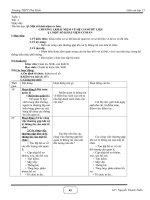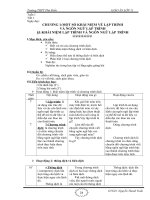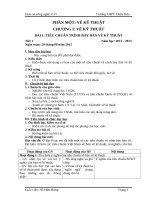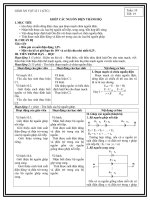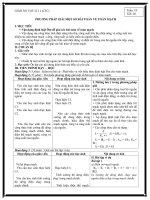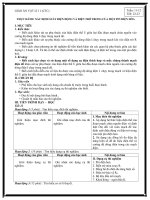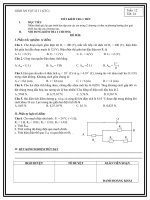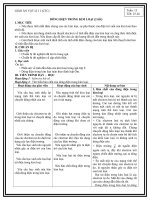giao an 11 hoc ky 1
Bạn đang xem bản rút gọn của tài liệu. Xem và tải ngay bản đầy đủ của tài liệu tại đây (467.99 KB, 82 trang )
Period 1 – Unit 1
LESSON 1: READING
1. Objective: By the end of the lesson, Ss will be able to:
- Develop such reading micro – skills as scanning for specific ideas, skimning for general
information, and guessing meaning in context;
- Use the information they have read to discuss the topic.
2. Teaching aids Textbook, handouts
3. Anticipated problems: Ss may need help with the discussion task, so T should be ready
to help them.
4. Procedure:
STEPS
WORK
ARRANGEMENT
3’
7’
WARM-UP
- Complete the sentence by filling the gaps with the suitable words. A
A______ in need is a _______ indeed.
→ Answer: … friend … friend …
Before you read.
a. Discussing the picture and poem.
- T asks the whole class to look at the picture on page 12 and asks some
questions about it.
b. Pre-teaching vocabulary
- acquaintance (n): người quen
- two-sided affair (n)
- give-and-take (n)
- constancy (n) → constant (adj)
- enthusiasm (n)
- changeable (adj)
- Loyalty (n) → loyal (adj)
- rumour (n)
- gossip (n): chuyện ngồi lê
- trust (n)
- sympathy (n) – sympathize (v)
- sorrow (n)
- pursuit (n)
- suspicion (n) – suspicious (adj)
Arrangement
individual work
Pair work & whole
class
15’
WHILE YOU READ
1. Task 1: Fill in each blank with a suitable word/phrase
- Ss guess the meaning of the words based on the contexts
- Read the sentences cafully to understand the meaning roughly. Then choose
the most suitable one to fill in the blank.
- Asks Ss for their answers and tells them to explain their choices.
1. mutual 3. unselfish 5. give-and-take
Whole class,
individual, work a
pair work
10’
2. incapable of 4. acquaitance/friend 6. loyal to 7. suspicious
2. Task 2:
- Asks Ss to do the task individually then compare with a partner.
- Calls on some Ss to give their answers and asks other Ss to say whether
they agree/disagree
- gives feedback and the correct answer.
* Answer: B
3. Task 3: Answer the questions
- Asks Ss to do the task, decide what information they need to fill in the text,
then underline the key words.
- Ask Ss to work individually to do the task
- Calls on some Ss to write their answers on the board and ask them to
explain their choices
- Gives the correct answer
(See teacher’s book on page 18)
Whole class
individual work and
pair work
Whole class
dividual work &
pair work
7’ AFTER YOU READ
- Asks Ss to work in pair to discuss the question in the book
- Goes around to help Ss when necessary
- When finishing, asks every two pairs to share ideas.
- Call on some Ss to report their ideas to the class.
- ↑ gives feedback
Pair work group
work & whole class
3’ WRAPPING UP
- Summarises the main points
- Assigns homework
Whole class
Period 2 – Unit 1
LESSON 2: SPEAKING
1. Objective: By the end of the lesson:
-Ss will be able to describe the physical characteristies and personalities of their friends, using
appropriate adjectives
2. Materials: Textbook, handouts.
3. Anticipated problems: Ss may not have enough voc to talk about the topic, so T should
be ready to provide help.
4. Procedure:
STEPS
WORK
ARRANGEMENT
3’
10’
10’
WARM-UP
- Gives Ss a picture and makes question. Who can give me a short
description about her/him?
- Answer: She/He is of medium height
She wears her hair in ponytail
She has got an aval face with dark brown eyes
1. Task 1:
- Before letting Ss do the task 1, asks them to read useful language on page
16.
- Then provides them some adjectives/expressione used to describe peaple’s
appearance.
- Give Ss a handout of these adjectives and expressions
- Asks Ss to work inpairs to describe the people in the picture, and then calls
on some Ss to present their answers
- Gives feedback.
Ex: 1. The boy is about 16. He may be short-sighted because he’s
wearing a pair of glasses. He has short black hair, a round face with a broad
forehead, a small nose, thin lips and a small chine. He’s quite good-looking.
2. The girl …
3. The man …
4. The woman …
2. Task 2:
- Enplains some adjectives quickly
- caring (adj): kind, helpful (chu đáo)
- hospitable (adj): generous and friendly (hiếu khách)
+ Divides the class into groups of 6 with a group leader. They discuss and
the leader will take notes of the ideas.
- goes around to offer help when Ss discuss
- Calls on some Ss to report the results of their discussion.
- Ss’answer may be: “My group thinks that being caring in the most
important in friedship because when friends care about each other, they’ll
Work anangement
whole class
Whole class and
pair work
Whole class and
group work
Whole class and
pair work
20’
know when to share happiness or difficulty with their friend …”
3. Task 3:
- Explains the phrases and makes questions, for example
+ what’s his name / could you tell me his name?
+ what is his date of birth / when was he born?
+ what’s he like (tính cách) / Is he friendly?
+ what are his hobbies? What does he like doing in his freetime?
+ what does he look like (diện mạo) …
- Explain some adjectives:
- quick – witted (adj): nhanh trí.
- good – natured (adj) kind, friendly and patient: tốt bụng
- Asks Ss to work in pairs to perform the interview in 7ms and goes around
to offer help.
- Calls on some pairs to perform the interview
- feedbacks
2’ WRAPPING UP
- Summarises the main points of the lesson
- Assigns homework
Whole class
Period 3 – Unit 1
LESSON 3: LISTENING
1. Objective: Ss will be able to: Develop such listening micro – skills as intensive listening
for special inf and taking notes while listening.
2. Materials: Textbook, cassette tapes, handouts
3. Anticipated problems: Ss may not be familiar with the note-taking task, so T should
provide them some tips to deal with the task.
4. Procedure:
STEPS
WORK
ARRANGEMENT
5’
WARM-UP
Talk about best friend
1. who is your best friend ?
2. How did you meet him/her?
3. How long have you known each other?
4. What qualities do you admire in your best friend?
Work anangement
Individual work and
whole class
5’ BEFORE YOU LISTEN
a. Vocabulary pre-teach
- aportment building: toà nhà có nhi ều căn hộ
- sense of humour: khiếu hài hư ớc
- give sb a ring: phone s.b
- go through a rough time: trải qua thời kỳ khó khăn
Whole class
10’
WHILE YOU LISTEN
1. Task 1:
- Listen to the tape and pay attention to the key words
- Dedide whether the statements are true/false
- Asks Ss to work in groups of 4 to compare their answers.
- Calls on Ss to answer and explain their answers.
- Gives the correct answer:
a. Lan’s talk:
1. F (They used to live in the same building there)
2. F (It’s what people think)
3. T
4. F (Lan went to DoSon first, then called H, so Ha rode on her motordike to
Do Son to meet Lan)
5. T
6. F (They have been best friends since Lan’s trip to Do Son
b. Long’s talk
Individual work,
group work and
whole class
17’
1. F (they met in college)
2. F (Minh was a guitarist)
3. T 4. T 5. T
2. Task 2:
- Plays the tape again for Ss to compare their notes.
- After listening, gets Ss to work in pairs and check their answers.
- Calls on Ss to give the answers, corrects answers.
How and where did they meet
What do they like about their
friends?
Lan
- They used to live in the same
apartment building in Ha Noi
- Lan went on a holiday in Do
Son and Ha went there to help
her.
- Ha’s very friendly and helpful
- Ha’s sociable. She’s got
many friends in Do Son and
she introduced Lan around
Long
- They met in collage
- Minh played the guitar, and
Long was a singer
- Thay worked together
- Minh has a sense of humour
- Minh likes to go to plays and
movies.
- Minh’s a good listener
- Minh is friendly and helpful.
Individual work,
group work and
whole class
5
AFTER YOU LISTEN
- Gets Ss to work in pair to talk about how Ha has been Lan’s best fried and
Minh has been Long’s best friend.
- Goes around to offer help and collect Ss’s mistakes.
- Calls on some pairs to present their answers
- feedbacks
Whole class a pair
work
3’ WRAPPING UP
- Summarises the main points
- Assigns homework
Whole class
Period 4 – Unit 1
LESSON 4: WRITING
1. Objective: Ss will be able to: write about a friend, read or imaginary, using the words and
expcessions that they have learned in previos lessons.
2. Materials: Textbook, handouts
3. Anticipated problems: Ss may not have sufficient voc to write about the topic, so T
should be ready to assist them
4. Procedure:
STEPS
WORK
ARRANGEMENT
3’
WARM-UP
- Friend
- Asks Ss to expand it by adding the beginning or the ending of what’s
already written to make a meaning full sentence.
- Answers: S
1
I like a friend
S
2
I like a friend who’s friendly
S
3
I like a friend who’s friendly and helpful
S
4
…
Work arrangement
- group work
9’
PREPARING SOMETHING TO WRITE
- Ss’ writing should include three parts:
(1) general inf about their friend
(2) his/her physical characteristics and personalisties
(3) what Ss like about the friend.
Example:
(1) She is ……, she lives near ……, she has never married, lives alone ……
(2) – quite young in spirit, extremely generous, a very active person ……
- in her late twenties, thick brown hair, dark brown eyes, has a kind smiling
gace, …
(3) friendly, good natured, caring ……
- T gives the adjectives/ expressions to Ss, so they can describe their friend’s
appearance/ personalities.
- Gets Ss prepare an outline for their writing and exchange it with their peer.
- Goes around to offer help and gives corrective feedback
Whole class
20’ WRITING
- Gets Ss to write about their friend in 15 minutes
- Goes around to observe and offer help
Suggested:
Of all my friends, I like Thu the best. She’s my classmate and we have been
Individual work
friends for a long time. We met one day while she looking for a book I
needed in the school library.
She has a nice face and when you meet her the first thing you notice are her
beautiful dank eyes
She’s S.O I like because she’s clever and she has a good serve of humour.
We also have something in common because we both like reading novels and
watching films.
I hope that we will be friends forever.
10’
FEEDBACK ON SS’ WRITINGS
- Asks Ss to exchange their writing with another student for peer correction
- Goes around and collects mistaked and errors
- Collects some writings for quick feedback
- Provides general comments on the writings.
Notes for checking:
+ Content: Which’s the interesting / boring port? Are there enough details?
Are there any sentences which you don’t understand?
+ Organization: Is it coherent? Are you sure there’s a topic sentence for each
paragraph? Are there any sentences out of place?
+ Grammar / spelling: Do any problems about grammar or spelling exist?
Pair work and
whole class
3’ WRAPPING UP
- Summarises the main points of the lessons
- Assigns homework
Whole class
Period 5 – Unit 1
LESSON 5: LANGUAGE FOCUS
1. Objective: Ss will be able to: distinguish the sounds /dʒ/ & /t∫/
- pronounce the words and sentences containing these sounds correctly
- use some structures containing infinitive with and without “to” appropriatedly
2. Materials: Textbook, handouts
3. Anticipated problems: Ss may find it difficult to pronounce the 2 sounds, so T should
prepare a lot of prance.
4. Procedure:
STEPS
WORK
ARRANGEMENT
10’
PRONUNCIATION
a/ Pronouncing the two seunds separatyly
- Models the 2 sounds /dʒ/ & /t∫/ for a few times and explains the
differences in producing them
+ The phonetic sound /dʒ/ is a voiced palatal
+ The phonetic sound /t∫/ is an unvoiced friactive palatal.
b/ Pronouncing words containing the sounds.
- Reads the words in each column all at once
- Reads and asks Ss to repeat
- Asks Ss to practice pronouncing the words in pairs.
- Goes around providing help
c/ Practising sentences containing the target sounds
- Asks Ss to practise the sentences in pairs
- Goes around to providing help
- Asks some Ss to read the sentences and give feedback
Work arrangement
Whole class,
individiual work
and pair work.
10’
GRAMMAR
1/ To – inf: Presentation
- Asks Ss to comment on the use of to + inf in these examples
(I have letters to write / There is plenty to do)
- Continues writing some other sentences on the board.
I’m sorry to trouble you
It’s easy to please that customer
The pie is too hot to eat
- To inf after adjectives
→ adj + to_inf; adj + too / enough + to + inf
- Asks some Ss to give some similar example
b/ Practice
Exercise 1. Asks Ss to do Ex 1 individually and then compare their answers
with another student
- Calls on some Ss to read out their answers
- Gives correct answers (on page 22 of Teacher’s book)
2/ Infinitive without to (bare infinitive)
Whole class
individual work and
pair work
Group work and
20’
a. Presentation
- Asks Ss to give some verbs that are followed by bare inf, then makes clear
that.
- After feel, hear, watch, see, notice, observe, perceive, smell, taste, listen to
- After let/make: let sb do sth = allow sb to do sth
Make sb do sth = force sb to do sth
b. Practice
Exercise 2:
- Asks Ss to do Exercise 2 in pairs
- Asks them to compare anwers with another pair
- Asks some Ss to write their anwers on the board
- feedback and gives correct answers.
1. The police watched them get out of the car
2. They let him write a letter to his wife
3. I heard them talk in the next room.
4. The customs officer made him open the brigcase
5. The boy saw the cat jump through the window
6. Do you think the company will make him pay some extra money?
7. I felt the animal move towards me
8. Do you think her parents will let her go on a picnic?
whole class
5’ WRAPPING UP
- Summarises the main points of the lessons
- For homework, Ss review the points that have been covered in the lesson
and do the extra exercise.
Whole class
Period 6 – Unit 2
LESSON 1: READING – PERSONAL EXPERIENCES
1. Objective: Ss will be to develop such reading micro-skill as scanning for specific ideas,
identifying the sequence of events and guessing meaning in context, using the information they have
read to discuss the story
2. Materials: Textbook, handouts
3. Anticipated problems: Ss may need help with discussion task – T helps
4. Procedure:
STEPS
WORK
ARRANGEMENT
3’
WARM-UP
Asks some questions:
1. Would you feet embassassed or upset if you forgot your mother’s birthday
or your father’s birthday?
2. If you made a stupid mistake, how would you feet?
3. Is there any one/thing that you’ve very moud of?
Word anagement
Whole class
5’
BEFORE YOU READ
- Asks Ss to work in pairs and try to make sense of the pictures on page 22.
Then gets them to put the pictures in the order that they think is most
appropriate.
- Calls on some pairs to present their idias.
Pair work and
whole class
22’
WHILE YOU READ
1. Task 1:
- Asks Ss to read the passage silently.
- Explains some words by telling the meaning of the words in VietNamese
- Asks Ss to do task 1 then checks the answers with the whole class.
- Answers: 1. glanced 3. embarrassing 5. sneaky
2. making a fass 4. idols
2. Task 2:
- Asks Ss to do task 2 and explain his/her answer.
- give corrective feedbacke
- Answer: 1. picture 1 3. f 5. a
2. b 4. e 6. c
3. Task 3:
- First, Ss should skim the 5 questions to understant them
- Then, they should go back to the passage and locate the key words in the
passage
- After that, they should read around the key words carefully to find the
answer
- Gets Ss to check their answers with a peer
- Calls on some Ss to write their answer answers on the board and ask them
to explain their choices.
- Gives the correct answers.
1. A floppy cotton hat
2. To buy a floppy cotton hat
Pair work and
whole class
Individual work,
pair work or whole
class
Individual work,
pair work and whole
class
3. A ward of dollar notes look exactly like those her father had give her.
4. She thought that was her own money and the boy had stolen it from her.
She wanted to take it back without making a fass
5. She bought the hat of her dream
12’
AFTER YOU READ
- Asks Ss to work in groups of 3 or 4 and discuss the questions.
- Some structures that can be used for giving suggestions.
Eg: embrarrassed / ashamed / confused / sad / unhappy / uneasy /
uncomfortable
- Goes around to check and offer help.
- Calls on the groups to tell the explain their choice
- Gives corrective feedback
Group work and
whole class
3’ WRAPPING UP
- Summarises the main points of the lesson
- Assigns homework
Whole class
Period 7 – Unit 2
LESSON 2: SPEAKING
1. Objective: - Identify structures that are used to talk about past experiences and their influences on
one’s life;
- Use these structures to talk about a past experience how it affects their life
2. Materials: Textbook, handouts
3. Anticipated problems: Ss may have prblem using present perfect and past simple when talking
about the past.
4. Procedure:
Steps
Work
Arrangement
5’
WARM-UP
Gives some pictures (photocopy) and adjective to students in class, and asks: How do
the people in the photos feel?
+ Adjectives: hapy, angry, frightened, ralaxed, excited, bored …
Then asks: 1. Have you had some persenal experiences ?
2. How do you feel when you meet a famous filon star?
3. How do you feel if you fail your exam / get bad marks / grades?
Individual
work
7’
1. Task 1:
- Introduces the taks and gets Ss todo it individual,
- Introduces the stranctures:
Make S.O do S.th
Make S.O + Adjective
Note: We can take the form of either an Infinitive with “to” or _ing gerungd.
Ex: To speak English to a native speaker makes you unterested in learning English.
Speaking English to a native speaker makes you more interested in learning
English.
- Suggested Anwers: 1. d 2. c 3. a 4. d 5. e
Individual
work, pair
work and
whole class
15’
2. Task 2:
- Asks Ss to work individually then compare with their friends
- Drows Ss’s attention to the questions asked in the present perfect / past simple when
talking about a past experience and its present effects.
+ Present perfect: Have you ever been to Egupt?
+ Simple past: When did you go there?
Who did you go with?
Did you enjoy your visit to Egypt?
- Asks Ss to practise speaking the dialogue.
Answers: 3/h 4/a 5/e 6/g 7/c 8/f
Individual
work, pair
work and
whole class
15’
3. Task 3:
- Hỏi về kinh nghiệm đã trải qua: Have you ever?
- Hỏi về chi tiết của kinh nghiệm đó: How did it happen?
When did it happen?
- Asks Ss to work in pairs to have a conversation
- Calls on some pair to perform their coversations in front of the class.
- feedbacks and gives final comments.
Pair work and
whole class
3’
WRAPPING UP
- Summarises the main points of the lesson
- For homework, Ss write a paragraph about a past event thas has had an influence on
him/her
Whole class
Period 8 – Unit 2
LESSON 3: LISTENING
1. Objective: By the end of the lesson, Ss will be able to:
- Develop such listening micro-skill as listening for specific information and taking
notes while listening
2. Materials: Textbook, cassette tapes, handouts
3. Anticipated problems: Ss may not have sufficient VOC to talk about the topic so T
should be ready to assist them. Ss may not able be familian with the note-taking task to T should
provide them some tips to deal with the task.
4. Procedure:
STEPS
WORK
ARRANGEMENT
3’
WARM-UP
Gives a picture (A building on fire) and asks Ss:
1. What’s it?
2. How do you feel when you see a fire?
3. What would you do if you saw a fire?
Whole class
7’
BEFORE YOU LISTEN
- Asks Ss to describe the picture on page 27 of the textbook by questioning:
+ What can you see in the picture?
+ What is happening?
+ Who are these people?
New words:
- memorable (adj): đáng nhớ
- terrified (adj): Sợ hãi
- scream (v): shout very loudly
- replace (v): thay thế
- gas stove (n): bếp ga
- embrace (v): ôm, ôm ghì
- escape (v): trốn tho át
- protect (v): bảo vệ
- Helps Ss pronounce these words correctly.
- Presents the meaning of these word from the class
Pair work and
whole class
25’
WHILE YOU LISTEN
1. Task 1: True or False
- Gest Ss to read through the statement to understand them and underline key
words (christina / business woman)
- Plays the tape once for Ss to listen and do the task
- Gets Ss to find a partner to check their answers with
- Plays the tape one / two more times if necessary
Answers:
Individual work,
pair work and whole
class
1. T 2. F (13 years a go) 3. F (in the kitchen)
4. F (She was sleeping not reading) 5. T
2. Task 2: Gap filling
- Asks Ss to do Task 2 individually without listening one more time. If they
cannot, plays the tape again
- Read the passage carefully for the missing information they need to fill and
guess the answer.
- After that, tells Ss to work in pairs and check their answers
- Calls on someone to give the answers.
- Provides the correct answers if necessary
Answer:
1. small 2. everything 3. family
4. replaced 5. took 6. appreciate.
7’
AFTER YOU LISTEN
Before gettings Ss to discuss, Teaches Ss some useful expressions of asking
for and give opinion. Example:
a. Asking for opinions: What’s your feeling about …?
Do you have any opinion about …?
+ I think / I agree / well, maybe, but …
I believe … / that’s true, and … / I don’t think so, I …
→ Family is more important than anything else because it can’t be replaced /
it gives me love, support …
Group work and
whole class
3’
WRAPPING UP
- Summarises the main points
- Assigns homework
Whole class
Period 9 – Unit 2
LESSON 4: WRITING
1. Objective: By the end of the lesson, Ss will be able to:
- Write a personal letter telling about a past experience, using the structures and VOC
that they have learned in previous lessons
2. Materials: Textbook, handouts
3. Anticipated problems: Ss may not have sufficient VOC to write about the topic so,
Teacher should be ready to help them
4. Procedure:
STEPS
WORK
ARRANGEMENT
5’
WARM-UP
- Delivers handout: Completing sentences, using adjectives in the box:
Proud, frightened, angry, sad, embarrassed, jealous
1. He was very …… when his mother appeared on TV with his teacher.
2. He was very …… when his best friend went out with the girl he really
liked
3. He was very …… when he sent her a birthday present on the wrong day.
4. She was very …… when someone stole her money
5. She was very …… when she heard that his aunt died
6. He was very …… when he saw those big dogs running touward him
* Key words: 1. proud 2. jealous 3. embarrassed
4. angry 5. sad 6. frightened.
Then ask When did you last feel angry /surprised /upset/jealous ..?
Whole class
10’
PREPARING SS TO WRITE
- Asks Ss to read the task silently and work out What they are required to write
about
- Draw a network of ideas on the board
- Explains cleanly the verb tenses that can be used for deseribing a past event
(simple past, past perfect, past continuous). Reviewing the uses of these tenses if
necesssary.
+ The past simple is used to …
+ The past continuous is used to …
+ The past perfect is used to …
- Gets Ss to plan their stories according to the questions on the board.
A saimple outline
What happened ? I nearly drowned
When it happened ? A year ago, my last summer vacation
Where it happened ? A river near my grandparents’house
How it happened ?
When I was swimming, I suddently caught a cold, I
felt dizzy and I was too weak to swim
Who was involved ?
Some of my friends were also swimming at that time,
one tried to save me.
How it affected you ? I learned that life is so important.
Individual work,
pair work and whole
class
Individual work
20’
WRITING
- Gets Ss to write their own letters in 10ms.
- Then work in pair, exchange their letters and correct each other
- Goes around and offers help
Individual work and
pair work
7’
FEEDBACK ON SS’ WRITING
- Chooses one letter and reads it to the class
- Feedbacks and gives final comments offerwards.
- Draws Ss’ attention to the format of the letter
the organication of ideas and language use
↓ ↓
Five parts in a (verb tenses)
personal letter
(Heading, salutation (Greeting)
Body closing and sigorature)
3’
WRAPPING UP
- Summarises the main points of the lesson
- Reviews how to write letters.
Whole class
Mos
unforgettable
experience
Where it
happened
How it
happened
How it
affected
you
Who was
involved
When it
happened
What
happened
Period 10 – Unit 2
LESSON 5: LANGUAGE FOCUS
1. Objective: - Distinguish the sounds /m/, /n/ and /ŋ/
- prodounce the words and sentences containing these sounds correctly
- Distinguish the uses of different verb tenses: Simple present for indicating the past, simple
past, past continuous and past perfect.
- use these verb tenses to solve communicative tasks.
2. Materials: Textbook, handouts
3. Anticipated problems: Ss might have difficulty distionguishing and using different verb
tenses correctly. There fore, T should be ready to assist them.
4. Procedure:
STEPS
WORK
ARRANGEMENT
7’
PRONUNCIATION
1. Distinguishing sounds:
- Models the 3 sounds /m/, /n/ and /ŋ/ and explain the differences in
producing them.
+ When “n” follows “m” in the same syllable it’s usually Not pronounced
(column, autumn, solemn)
+ “ng / ngue” at the end of the words are always pronounced /ŋ/ (sing,
tongue, walking)
+ The letter “n” before “g” or “k” is pronounced /ŋ/ (kings, hungry, thank,
think)
- Practicing sentences comtaining the target sounds
+ Asks Ss to work in pairs and take turn to read aloud the given sentences
+ Goes around to listen and takes notes of the typical errors then corrects it.
Whole class,
individiual work and
pair work.
10’
GRAMMAR
A/ Presentation:
1/ Present simple: Express the idea that an action is repeated or usual. The
action can be a habit, a hobby a daily event, ascheduled event or something
that after happens
Ex: The train leaves every morning at 8am
The train doesn’t leave at 9 am
When does the train usually leave?
2/ Present continuous:
- Express the idea that something is happening now, at this very moment
Are you sleeping?
3/ Present perfect:
- To say that an action happened at an unspecified home before now. The
exact time is not important. So we can use the present perfect to describe our
experience.
Whole class
individual work and
pair work
25’
I have seen that movie 20 times
I think I have met him once before.
B/ Practice:
1. Task 1: Asks Ss to do Ex 1 individually and then find a partner to check
their answers with.
- Checks with the whole class and provides corrective feedback
Answer:
1. invites 2. sets 3. gets 4 waves
5. promises 6. carries 7. contains 8. has baked
9. is 10. is shining 11. are singing 12. is.
2. Task 2: Exercise 2
1. Simple past: S + Ved / V2
I saw a horror film last night
He didn’t wash his car
2. Past continuous: S + Was/were + V-ing
I was watching TV when she called.
Last at 6 pm, I was eating dinner
I was studying while he was waking dinner.
* Practice:
- Gets Ss to do Ex 2 individually and then find a partner to check their
answers with.
- Answer:
1. broke / was playing 2. wrote / was3. was working / broke
4. started / were walking 5. told / were having
6. didn’t listen / was thinking 7. phoned / didn’t answer/were doing
8. didn’t wear / didn’t notice / was driving.
3. Task 3: Exercise 3
a) Presentation: S + had + past participle
I had never seen such a beautiful beach before I went to HaNoi
We had had that car for 10 years before it broke down.
b) Practice:
- Asks Ss to do it individually and then find a partner to check their answers
with.
- Checks the answer with whole class and provides corrective feedback
1. had eaten / arrived 2. found / had taken 3. got / had closed
4. got / had left 5. got / had arrived 6. pair / had phoned
7. went / said / hadn’t arrived 8. had cooked / asked / cost.
Individual work and
pair work
Individual work and
pair work
3’
WRAPPING UP
- Summarises the main points of the lessons
- For homework, Ss review the usecof different verb tense that have been
covered in the lesson.
Whole class
Period 11: TEST IN 45 MINUTES
- Hướng dẫn nội dung kiểm tra 45 phút - Bài số 1
+ Đơn vị bài học: Unit 1 and Unit 2
+ Từ vựng và cấu trúc câu: Chuẩn bị toàn bộ
+ Ngữ pháp
* Unit 1: Frendship
- Infinitive with To
- Infinitive without To
- Gerund
- Writing about a friend
(describing physical characteristics / discussing personalities)
* Unit 2: Personal experiences
- Present simple indicating past time
- Tense revision: past simple
Past progressive
Past perfect.
- Talking about past experiences and how they affected one’s life
- Writing a personal letter to describe a past experience.
Period 13 – Unit 3
LESSON 1: READING – A PARTY
1. Objective: By the end of the lesson, Ss will be to able to:
- Develop such reading micro-skill as scanning for special ideas, and identifying and
correcting false statements.
- Use the information they have read to discuss celebration in their culture
2. Materials: Textbook, handouts
3. Anticipated problems: Ss may need to be provided VOC related to celebration and
festivals so that they can complete various learning tasks.
4. Procedure:
STEPS
WORK
ARRANGEMENT
3’
WARM-UP
Give Handout to Ss: Rearrange the following celebrations in the right order:
a/ Gold anniversary b. Diamond anniversary
c/ Ruby anniversary d. Silver anniversary
- Goes around and checks
- Explains and gives answer: d → c → a → b
+ Silver anniversary = silver wedding: the 25
th
anniversary of a wedding
+ Ruby … = ruby wedding: 40
th
…
+ Gold … = Gold wedding: the 50
th
…
+ Diamond …= Diamond wedding: the 60
th
…
Pair work
12’
BEFORE YOU READ
- Gets Ss to work in pair and try to make sense of the pictures on page 32
- Calls on some Ss to answer the questions
- Checks with the class.
+ Suggested answers:
1. The people are members in a family.
2. They are celebrating / a birthday party
A gold wedding.
* New words:
- mark (v): đánh dấu
- milestone: an important event or stage in one’s life
- lasting (adj) continuing a long time
- golden (adj) made of gold
- blow out (v): thổi nến
- celebrate (v): làm lễ kỷ niệm
- Presents the meanings and pronounce these words
- Asks Ss to listen and repeat carefully
Pair work and
whole class
10’ WHILE YOU READ
1. Task 1:
- Tells Ss to read the passage silently and then do Task 1. First, Ss should
skim the seven statements to understand them. Then, should go back to the
Pair work and
whole class
10’
passage and locate the key words in it.
- Find out the correct answers
- Checks the answers with the whole class.
Answer:
Birthday Wedding
1. People sing a song
√
2. People eat cakes
√
3. People receive cards and gifts from
friends and relatives
√ √
4. People joke about their ages
√
5. People remember their wedding days
√
6. People go out to dinner
√
7. People blow out candles, one for each
year
√
2. Task 2:
Instructs Ss to go back to the passage and locate the words.
Example: In sentence 1, these might be:
Lisa’s family and friends – eighth birthday
2. make eakes and ice-creams – birthday
- Tells Ss to check their anser with a friend
- Present and explains their answers.
Answer:
1. eighth → seventh 2. makes → eats
3. foods → presents 4. anniverary → ages
5. months → years 6. 5
th
→ 50
th
7. silver → golden.
Individual work,
pair work and whole
class
Individual work,
pair work and whole
class
7’
AFTER YOU READ
- Asks Ss to work in small groups of 3 or 4 and discuss the questions
- Gives comparison and contrast
Ex: + In the US, people … put in VietNam, people …
+ Americans … while VietNamese …
+ Americans … in contrast, VietNamese …
- Goes around to check and offers help
- Gives corrective feedback
Group work and
whole class
3’
WRAPPING UP
- Summarises the main points of the lesson
- Assigns homework: “Write a paragraph about how VietNamese people
celebrate their birthdays / wedding anniversaries”
Whole class
Period 14 – Unit 3
LESSON 2: SPEAKING
1. Objective: Ss will be able to:
- Use appropriate language to talk about parties and negotiate how the plan them
- Use appropriate language to invite people to come to parties
2. Materials: Textbook, handouts
3. Anticipated problems: Ss may have little experience negotiating in English, so T should be ready
to provide them with appropriate language to do so.
4. Procedure:
Steps
Work
Arrangement
5’
10’
10’
WARM-UP
Handout: Complete the word map with words from the box and add more words to
each category
Coloured lights, dancing, dress, milk, pizzas
Party
- Asks Ss to work in groups: Gap filling.
- Discuss and apply more more words for each categozy
- Suggested answers:
+ Decoration: flowers, balloons, coloured lights …
+ Activities: singing, playing games, dancing
+ Clothes: formal / informal, T-shirt-skirt, chess suit, pull, Jeans …
+ Special food / drink: dot-dog, humburgers, pizzas, coke, fruit juice, mineral
water, bread …
1. Task 1:
- Introduces the task, goes over the questions with the class, explains new words if
necessary.
- Asks Ss to do it individual
- Goes around the class to check and offer help
2. Task 2:
- Tells Ss to work in pairs and tell each other about the parties they have been to,
based on the outlines they have made for Task 1.
- Goes around to check and offers help
- Calls on some pains to perform their conversations in ……
- Feedbacks / gives final comments
Individual
work
Activities
dancing…
Clothes dress
…
Special food
and drink
milk…
Deceration
colouted lights
…
10’
12’
3. Task 3:
- Introduces the task 3
- Asks Ss to practice making questions for above items
+ butget: How much do you spend for your party
+ date a time: When do you organize your party?
+ who to invite: Who have been invited to your party?
+ place: Where do you organize your party?
+ formal / Informal dress: What kind of clothes do you wear at the party?
+ decorations: How do you decorate your party?
+ entertainment: What activities will take place?
+ food and drink: What foods and drinks will be serverd?
Ex: P1: Tell me about your party
P2: We’re having a Halloween party
P1: When are you going to have the party?
P2: At 7p.m on October 31
st
P1: How many people do you plan to invite?
P2: About 30 people
……
- Divides class into small groups of 3 or 4 and asks them to do Task 3, then goes
around to check and offer help.
- Takes note of Ss’ errors and corrects them.
4. Task 4:
- Tell the rest of the class out your party. Try to convince them to come
- Provides some verb tenses and structures Ss might want to use when informing
about their coming parties
Future tense: - going to
- plan to do s.th
- intend to do s.th
- expect to do s.th
Ex:
- We’re planning to have a famous student’s music band play in our party / We’re
expecting 200 people to come and have fun with us …
Model:
We’re having a Halloween party at 7 pm on October 31
st
. Would you like to
come? We have also invite our English teacher – Ms Hong. When coming to our
party, you can dress up as witches, ghosts or monsters. There will be lots of food
and drink that you like such as pizzas, hamburgers, coke, fruit juice. Of course,
there will be dancing and some exciting fames with interesting prizes for the
winners.
Group work
and whole
class
3’
WRAPPING UP
- Summarises the main points
- For homework: write a paragraph about a party they have been to.
Whole class
Period 15 – Unit 3
LESSON 3: LISTENING
1. Objective: By the end of the lesson, Ss will be able to:
- Develop such listening micro-skill as intensive listening for specific information
2. Materials: Textbook, cassette tapes, handouts
3. Anticipated problems: Ss may not have sufficient about VOC to talk about the topic, so
T should be ready to assist them.
4. Procedure:
STEPS
WORK
ARRANGEMENT
5’
WARM-UP
- Divides class into 3 or 4 groups: write words related to birthday and
birthday party in 5’
- Which group has more correct words will win the game
- Suggested answers: age, ballon, birthday, blow out, cake, candle, counds,
candy cookies, chocolate, confeth, gift / present, icing, flowers,fun, party,
song, decoration …
Group work and
whole class
5’
BEFORE YOU LISTEN
- Asks Ss to cover their books and look at the pictures in the book: guess
what they are going to listen about.
- Tells Ss to open their books and work in pairs to answer the questions on
page 36
- Calls on some Ss to answer then corrects again.
New words:
- icing (n): kem lòng trắng trứng
- decorated (adj): được trang trí
- clap (v): vỗ tay
- Helps Ss to pronounce these words
- Presents the meanings of them from the class.
Pair work and
whole class
15’
WHILE YOU LISTEN
1. Task 1: True or False
- Tells Ss to read through the statement to understand them and underline key
words
- Plays the tape once for Ss to listen and do the task
- Checks their answers with a partner.
- Plays the tape one or two more times and pauses at the answers for them to
eatch
Answers:
1. F (the party began at about 3 in the afternoon
2. F (not over 20, about 20 people)
3. F (at 4:30 they cut the cake)
Individual work,
pair work and whole
class

